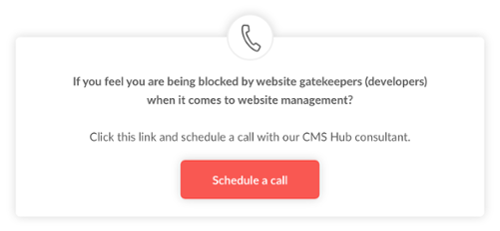How can the new CMS Hub and Theme-based website help you in your marketing efforts?
Recently HubSpot announced the release of the new CMS Hub, which is essentially a cloud-based Content Management System. As building CMS-based websites is the bread and butter of our business here at Clickray, I decided to share my thoughts with you. In this post, I will explain the key values of the new CMS Hub, including the new Theme-based website building technique, and how they help marketers build remarkable customer experience.
Reducing friction between marketing and IT departments.
Let the marketers take full control of the website while preserving its security and scalability.
The idea of allowing marketers to take control of the website has been around for almost as long as the internet exists. Many CMS vendors attempt to resolve this issue. However, in the end, each one of their solutions ends up being a trade-off between providing marketers with more control of website contents and preserving appropriate security as well as allowing for ease of maintenance and broad scalability. Below is a graph that maps how CMS Hub compares with the other top-performing CMS vendors in the context of scalability and ease of use for marketers.
Mapping Company Growth against Ease of Use for Marketers
On the left side, we see stages of company growth; the company's need for additional functionality increases as we move upwards. However, the level of difficulty for marketers moves along the horizontal axis, from difficult to easy (left to right).
In the upper left quadrant, we see a grouping of CMS vendors that offers exponential scalability, meaning they can provide comprehensive functionality needed when the company is growing. Here’s a list of examples presenting such functionalities:
- Serverless functions
- Activity logging
- Custom CDN configuration
- Multi-brand domain configuration
- Dynamic content
- 99.99% up-time
- URL mapping
- Partitioning
- Reverse proxy support

The trade-off here is that although they have exponential functionality, these CMS are very rigid and difficult for markets to use as they require developer intervention to do structural changes or create new site pages.
This consequently creates friction between marketing and IT, exposing a major obstacle in company growth as more resources are spent on managing the system rather than expanding customer experience. On the other hand, the lower right quadrant presents CMS that makes it very easy for marketers to create new pages or update content on websites. But the other trade-off here is that these CMS lack the above mentioned functionality, which is required to ensure company growth.
CMS Hub is the only system proficient enough to appear in the upper right quadrant. As a product expressing disruptive technology, CMS Hub doesn’t force you to make a choice between the ease of use and functionality but rather is the only system that enables you to utilize both of the traits.
How exactly is CMS Hub so easy to use for marketers?
Introducing the Theme-based concept of building websites.
With the introduction of the new CMS Hub, Hubspot released a new concept of developing and managing websites. The old concept of HubSpot CMS focused around templates, which acted as the building blocks of website pages. The main flaw in the Template-based approach was that it required more technical skills to make structural adjustments.
With the introduction of Theme-based concept, marketers can now do more with their websites. Themes essentially are the top-level formats that define the look and the feel of a website, providing a marketer-friendly content-editing experience. Themes incorporate a number of digital assets that might include templates, modules, images, and other forms of content.





.gif)
